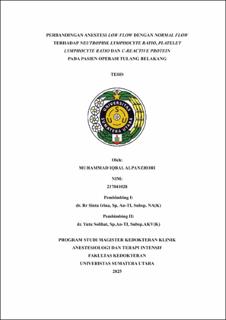Perbandingan Anestesi Low Flow dengan Normal Flow terhadap Neutrophil Lymphocyte Ratio, Platelet Lymphocyte Ratio dan C- Reactive Protein pada Pasien Operasi Tulang Belakang
The Effect of 20 mg Ketamine on 0.5% Bupivacaine 15 mg Intrathecal in Spinal Anesthesia for Lower Extremity Surgery

Date
2025Author
Alpanzohri, Muhammad Iqbal
Advisor(s)
Irina, Rr Sinta
Solihat, Yutu
Metadata
Show full item recordAbstract
Background:
Postoperative systemic inflammation contributes to complications and delayed recovery. Low flow anesthesia is believed to generate less oxidative stress and inflammation compared to normal flow anesthesia, but clinical evidence remains limited.
Objective:
To assess and compare the effects of low flow and normal flow anesthesia on inflammatory markers—Neutrophil Lymphocyte Ratio (NLR), Platelet Lymphocyte Ratio (PLR), and C-Reactive Protein (CRP)—in patients undergoing spine surgery.
Methods:
This comparative clinical trial involved 36 patients undergoing spinal surgery. Subjects were randomly assigned into two groups: 18 patients received low flow anesthesia and 18 received normal flow. NLR, PLR, and CRP were measured pre- and post-anesthesia. Statistical analysis was performed using the Wilcoxon test. In addition, patients' pain levels were assessed using the Numeric Rating Scale (NRS) during the postoperative period. To assess the relationship of pain scale in postoperative spinal surgery patients using low flow and normal flow anesthesia
Results:
In the low flow group, PLR increased significantly post-anesthesia (p<0.001), while NLR and CRP showed no significant change. Similarly, in the normal flow group, PLR increased significantly (p<0.001), but NLR and CRP remained statistically unchanged. PLR emerged as the most responsive marker to postoperative inflammation. There was no significant difference in pain levels 24 hours postoperatively between the two anesthesia methods
Conclusion:
Low flow anesthesia may attenuate systemic inflammatory responses compared to normal flow, particularly evidenced by a milder increase in PLR. It may be considered a safer anesthetic technique in terms of inflammatory impact during spine surgery.
